Suyog Ketkar's Blog, page 18
April 25, 2018
Micropoetry: Humility
As I prepare myself for
Another serve of humility,
I realize the distinction between
Medicine and food for thought
Is blurred in real life.
©Suyog Ketkar
#Gogyohka
#Micropoetry
Gogyohka, pronounced GO-GEE-YO-KUH, is a Japenese form of five-line micropoetry that—unlike Haiku or Senryu—doesn’t rest on the principle of the number of syllables. It relies on your power of speaking directly.
April 19, 2018
Micropoetry: Lullabies
Lullabies flew like water from eyes.
Cries were for the Ward,
Not for toys.
©Suyog Ketkar
Senryū is a form of micropoetry that contains 17 or lesser syllables spread across not more than three lines. Although this attempt isn’t driven by humor, Senryu mostly is used to describe the human aspect on a lighter note.
April 18, 2018
Be Content with Content
I would be amiss if I were to begin without defining the word content. That’s because it gives both a purpose and a premise to the topic: being content is feeling satisfied with your possessions or situations. But why this play of words in the title, you may ask. Here is why I rant…
Let us go back in time. Not far back into the world of typewriters and hand-written manuals. A couple of decades ago: when the concept of single-sourcing originated. I hadn’t joined the technical writing workforce then. Back then, the requirements were simple: get a single-sourcing tool to create everything from within one source. Then, use that source to generate the content for all formats. A lot has changed since. Yet the idea is to have a single repository generate the content. Just that we have complicated the process of creating and managing that content.
When I first single-sourced my product’s contents, I felt the need of creating a central repository for storing and generating the content—the likes of PDFs and CHMs. With that was born my organization’s server where resided the content. But, my requirements didn’t stop at that. I continued to remodel (or so I thought) my work processes to redefine the way I maintained that content. Then came XML, which helped me to tool-proof the product’s documentation.
Who knows, someday I may even put my head into Application Programming Interface (API), Internet of Things (IoT), and others. Did you notice how the story is becoming more about the tools of the trade than about the traded content? Sooner or later it will be about some other “hot” technology. As I continue to choose a (better) combination of tools and methodologies, I continue to steer farther away from the focus on the content. This could be your story, too.
[image error]
User Requirements are Progressive and Cyclical
A side note: a seamless user experience is easier to put on to paper than to put into practice. Agreed. Also, agreed that these days we have tools that we can use to instantly connect with our users. So, we can know which sections of our documentation get the most views. Or, which ones are the most or the least helpful.
From where I look, tools and methodologies originated to save our time and effort. But now, it looks like we have lost ourselves in managing them rather than the content. Let us not focus only on creating a content-management ecosystem. Instead, let us create a problem-solving ecosystem. Let us not forget that the users’ requirements are progressive and cyclical: the target for usability changes frequently.
It all starts with answering “why” and ends with exploring the answers for “what’s next”. Such content that continues to bridge this gap of “why” and “what’s next” is truly satisfying. A tool will only enable us to create quality content. It isn’t an end, but surely a means to an end. Let us solve users’ problems and be content with (the focus on) content.
April 1, 2018
The Delightful Life
Beholding the sunrise,
As I trace the ocean’s footprints on sands,
The drenched shore slips from under my feet,
Life becomes a delight.
Trailing through the woods,
As I listen to the rustling leaves that
Share with me the recitals of the Summer,
Life becomes a delight.
Humming that old song,
The forgotten lyrics of which
I happen to effortlessly sing,
Life becomes a delight.
Looking out of the window,
As I lull into thoughts that
Urge to kindle my imagination,
Life becomes a delight.
Weaving itself into a fabric of chronicles,
As the yarn of my words
Brings me to my self again,
Life becomes a delight.
Diving into the limitless love in those eyes,
As I happen to lose myself,
I happen to find myself, yes,
Life becomes a delight.
©Suyog Ketkar
March 26, 2018
Life is Black and White
In the moon’s silver,
In the food’s flavour,
From birth to death, altogether,
Life is Black and White.
As death parts us,
As and when happens a ruckus,
Within the slightest change of moods,
After all, Life is Black and White.
To those who take the world in their stride,
To the rains and the tide,
To either side of the Solstice,
After all, Life is Black and White.
Whether in a crowd or left alone,
With the passive self forlorn,
Through countless nights bygone,
After all, Life is Black and White.
Sans the haunting howls of ballads,
Sans the riddling verse in charades,
Sans the humming songs of an escapade,
After all, Life is Black and White.
©Suyog Ketkar
March 19, 2018
Why I Don’t Write Every Day
A lot of writers say they write every day. Some set daily goals, and some, weekly. A few may tell you to skip the weekends, but the idea is the same: write something every day. While the technique might work for them, it doesn’t work for me. Here is why it doesn’t:
Mostly, my full-time work takes the precedence over anything that relates to my non-work time activity. I do pen down thoughts that strike me during my work time. But, I don’t build on them at my work desk. I re-read the drafts and build on them later. This also means, for close to half of my writing effort, I am away from the keyboard.
Yes, I Don’t Write Every Day
I get why some of you might not agree with me: after all, I am a writer. If I were a wrestler, wouldn’t I invest time practicing and building muscles every day? I second the logic. But, writing doesn’t earn me my bread. My job does. I may be a writer at heart, but I am much more than just that. I play many roles, only one of which involves writing.
There is another reason: I’ve found that by not writing, I help my writing to be more productive. Yes, you read it right.
When I am not writing, I:
Create a list of what and how to write
Edit existing first cuts
Improve the flow of the story
Invest time in other activities, like photography
Read
Refine the plot
Reorganize the site
Structure the content of a post
Think about my composition
Either of this if I am not working on a fiction plot. I cannot push myself to create something every day even if that means wasting my readers’ valuable time.
The Flip Side of the Story
I agree that writing every day helps. If you are new to writing, noting down something and looking at it in days that follow helps you in improving your writing. Science proves that if you continue to repeat what you do, you sooner or later get better at it. Spending even as less as 15-30 minutes every day can improve your writing. This sounds logical.
Still, it fails to account for one thing: passion. The origin of this logic is that you train your brain to work into and follow a pattern until that becomes either a habit or a regular task on your work calendar. But, can you train your brain to generate passion? From where do you generate the self-motivation for you to give your best? The flaw here is that it is not practical for those who are not earning their bread out of the writing effort.
Most people write every day because they wish to get better at it. It makes sense for them to invest a part of their daily schedule toward perfecting this art. I am more bothered about the pleasure of writing than the result it generates. I do edit my work, but I am least interested in the ripples it creates in the mental ocean of creativity of others.
Summary
The primary purpose of rules—like writing every day—is to help us become more efficient. But, if the rules hinder the very path that leads us to raised efficiency levels, we must break them. Good writing, as I conclude, is not a destination, but a journey. Enjoy it while it lasts.
March 11, 2018
The Day Tour of Cambridge
I always thought that it takes the knowledge of places, a camera, and later some quality storytelling to create a good travelogue. But, here’s what I found I could add to the list: a friend. I was lucky to have Geoffrey walk me around Cambridge (Cambridgeshire, the old name). And, while we did enjoy the day tour, the chilling wind and the last five minutes of Rugby (Six Nations, 2018) blew the wits out of me.
[image error]
Let me start with the windy weather. The Saturday morning I underestimated the wind and wore my sleeveless jumper. Though the Sun shined bright throughout the day, the winds kept getting the better of me. And, for the creative sake of it, I will say that for all the while I kept walking my nose kept running.
[image error]
We began the day strolling through Jesus Green Lido. The park shares its borders with the river Cam on one side and the Jesus College on the other. We walked on the quayside until we could, then we broke into a part of the city. Walking is the best way to experience any city, especially this city.
[image error]
In Geoffrey’s words, the name of the city is a combination of the words Cam, which is the river that flows through the city, and bridge, which connects either side of the river. Oxford comes from oxen and ford—ford means a shallow river.
[image error]
Just a thought: what if the word “shire” in Cambridgeshire has any connection with the Hindi word Shahar, which means an urban settlement?
[image error]
There are a lot of old buildings in the city. Most of the old buildings have plaques that display the year of their construction—an age-old style; even Indore, my hometown, has buildings like that. Some buildings are as old as 1754. Maybe even older. The good thing is, the new buildings follow the design principles of the old buildings. This maintains the architectural aesthetics of the place.
Click to view slideshow.
After the Round Church, we decided to step into Caffé Nero. Over the coffee, Geoffrey and I compared the photographs we took—for an inspiration from the other’s works. Given that it was windy outside, a hot brew served its purpose reasonably well.

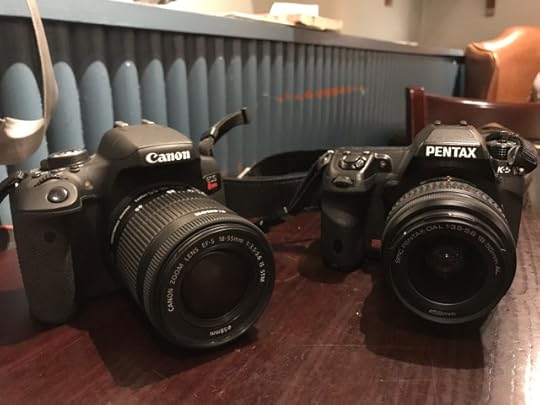
After the break, we walked past the Trinity College, which has the Newton’s Apple Tree. [Spoiler Alert: It is not the same tree under which Newton discovered the idea of gravity. Though seeds from the same Apple tree have planted this one here.]
Click to view slideshow.
While strolling the local weekend market, we stopped by a souvenir shop. We didn’t intend to buy anything, but we weren’t expecting what came next. The lady shopkeeper sat there soaking the gleaming Sun. She was getting only a little share of sunshine from between two buildings. She looked at us and said, “Enjoy the sunshine while you can. Don’t blame me later for not telling you.” True that inspiration can come from any source.






Throughout the city, I could find people taking photos. I even got a compliment for managing with a sleeveless jumper in that windy weather. This Southeast Asian guy didn’t realize that I wasn’t a local.
[image error]
A side note: I am not a shopping person. But, I did visit places like the Poundland and Primark. The variety of products and the price range suit the budget of the middle class. That’s a given for any city. What’s special for Cambridge is that all major shopping destinations are about 15 minutes to half an hour of walking distance.
[image error]
All major colleges in the University of Cambridge face the small area from the Fellows’ Garden to the Museum of Archaeology and Anthropology. Quite logically, the other side of the colleges is the Backs. The view from the rear of the buildings is comparably picturesque. [In the week that followed, Chris, a friend-cum-lead, helped me tour the Backs. We took some nice pictures there, too.]
Click to view slideshow.
Facing the Backs is Clare College behind which stands the Cambridge University Library. Yes, the same place that has a copy or record of every single work published from Cambridge.
[image error]
I must say that I felt alive even as I walked past the colleges of the University of Cambridge. The energy that flows through the streets over the weekends is noticeable. If I were to compare it with India, I would say that it is Kota of the United Kingdom. But then, why compare!
[image error]
When we walked past the Cambridge Corn Exchange, Geoffrey shared the history of the place. It is interesting how even after money becoming the medium of exchange it is still the word “Corn” that continues to be the term coined for it.
[image error]
The word “interesting” reminds me of something. If you are in the local market, don’t forget to buy “gifts for interesting people”. See how those words make you think that the gifts are as interesting as the receiver of the gifts. I got some yogurt-coated candies for my daughter—not from the same shop though. The ones that have dried Banana or Cranberry are mouthwatering. If you are in Cambridge and wish to munch on your way through the city, get yourselves some. They have a reasonable shelf-life, too.
[image error]
It is a British tradition to say sorry even if someone bumps into you. Chris says that in Britain you notice people singing their way through the crowd “sorry… sorry… sorry… oops… sorry… sorry… sorry” in rhythmic high-low-high-low notes. I must have caught on this habit because I remember saying sorry… only to realize a split second later that I had bumped into and was apologizing to a chair. Yes, I know!
[image error]
Every country, every city has its own way of greeting people. Cambridge greets people with a combination of colleges and pubs. Other than university education if there is anything that defines Cambridge then I’d say it is three “Ps”: parks, pubs, and punting. Mathematical Bridge, where we stopped next, is opposite to the Anchor pub. And, most likely, there too, you will see people punting over the Cam river. A short walk down from the Anchor pub is the Darwin College of Engineering. It is notable how so many prominent personalities have had a part of their lives spent in this city.

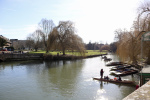
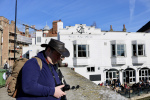
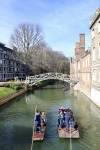
We spent the longest time of our day-long tour at the Anchor pub. We initially chose to sit outside to enjoy the weather, but in due course changed our minds. That way, I got some relief from the weather, Geoffrey got his much-needed Rugby dose and we both got the food. I even gave my expert opinion as we watched the post-match analysis.


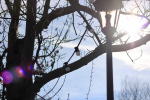
[image error]
Picture credit: Geoffrey
After the lunch, we set out to walk through Grantchester Meadows into the city walking past the James Dyson University of Engineering, the Judge Business School on the Trumpington Street, and Grand Arcade. As the dusk began to set it, we chose to skip two stops: The Museum of Archaeology and Anthropology and the Fitzwilliam Museum. I still managed to get some pictures around the areas.
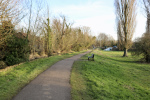


While neither of us wished to end the day by spending time in a city mall—all malls are the same—we ended up at Costa Coffee, in Grand Arcade, because most of the coffee shops were either full or about to call it a day. I am not sure why we refer to it as “calling it a day” while it isn’t even a day anymore after dusk sets in. Quite a funny observation. Anyway, Geoffrey had ordered for large coffees. So, we continued to talk until the coffees lasted.
Click to view slideshow.
With the dusk setting in and the temperature beginning to steep further down, we decided to curse the weather—another British tradition—and “call it a day”.
This memorable, short tour of the city has a lot of for me as a takeaway. Let me summarize the day-long tour:
Best guide: a friend
Best time to visit Cambridge: any, particularly February-March
Best companion: a camera
Best munchies: yogurt candies
Best food: any, as long as you top it with a beer
Best modes of transport: walking and punting
Best gear: well, surely not a sleeveless jumper if it is windy and February
Much like me, you too wouldn’t feel an outsider in Cambridge for long. Not because it is a global city. But because of the faces that smile back at you, prospering local markets, tourists looking for authentic local flavors, and the welcoming giggles of toddlers that attracts you as an outsider. The city grows more on you if you know a “local”.
I didn’t cover everything. I couldn’t. But then, I realize that if I cover everything in one visit, what will I plan the next visits for? Considering that I meant business when I flew into Cambridge, the city has intrigued me enough to shift the target of my next visits. As I head back home, I remain a travel bug hungry for more.
February 25, 2018
The Writer’s Chronicles – Episode 11
February 18, 2018
The Writer’s Chronicles – Episode 10
February 16, 2018
No Such Thing as Aspiring Writer
A lot of us yearn for writing our hearts out. While all we wish doing is to get our feelings across, it feels more rewarding to receive accolades for the simplicity in building that bridge between ours’ and readers’ hearts. And, I know that writing is not easy.
Still, there is no such thing as an aspiring writer.
We all enjoy witnessing sunrise and sunset or our occasional trips to sit by the lakeside. That’s easy because we become a part of nature. To register that experience, however, and to write that down for the readers to help them experience the same magic when they are sitting inside the walls of their imagination is complicated and tricky.
I still dare to say that there is no such thing as an aspiring writer.
How many times, tell me honestly, ideas strike you when you are in the shower? Does it not happen to you as frequently as it happens to me? So, you know that you don’t write yet you keep thinking. Right? It is such that even when you are not writing—on your laptop or a piece of paper—you are writing. Right? It is such that even when you are not involved in thinking creatively or critically, your mind makes memories by cherry-picking from your thoughts. Right?
That’s why I say that there is no such thing as an aspiring writer.
I say that not because I write or blog. I say that because I know that there is more to writing than just writing. We all have stories to tell. We all have experiences to share. We all do something in our lives, every day, that’s worth an inspiration to many. We all are products of the driblets of wisdom that trickle down our ever-contemplating brains.
Now that you begin to see how I see, you will agree that there is no such thing as an aspiring writer.
We are our own companions. Writing is a conversation that we have with ourselves. It is that speechless interaction, which decides what we do. During such conversations, we lose ourselves, we find ourselves, we look within, and we look outside. Through such conversations, we don’t merely see, we observe; we don’t merely think, we contemplate. It is writing that brings us back to ourselves.
True that there is no such thing as an aspiring writer.
As we have this conversation, you and I, our garden of emotions begins to flourish. We being to plant new seeds of thoughts. We bring our mental ears closer to our hearts to listen to the beats within. We begin to experience joy and warmth unspeakable. We may even venture walking barefoot through the thorny yet eternal pathway, called life, that eventually leads us to the light. But, most importantly, we begin to happen. We begin to realize.
The truth is, we cannot aspire to become what we already are! Which is why, I believe, there is no such thing as an aspiring writer.



